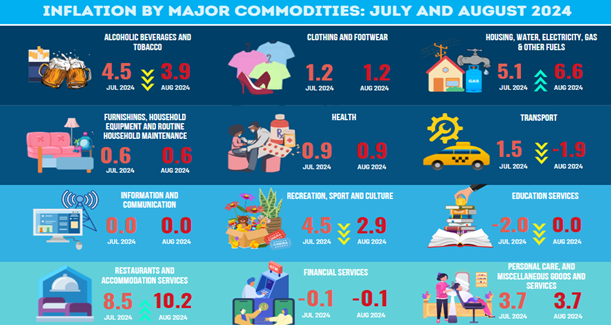Year-on-Year Inflation
The headline inflation rate in Aklan decelerated to 4.5 percent in August 2024, down from 6.4 percent in July 2024. This marks a significant slowdown in price increases for goods and services in the province. Notably, the inflation rate for August 2024 is identical to the rate recorded in the same period last year.
Despite the decline, Aklan's inflation rate remains higher than the national average, which stood at 3.3 percent for August 2024. However, it is slightly below the regional inflation rate for Western Visayas, which was recorded at 4.8 percent.


The downtrend in inflation of Aklan was mainly attributed to slower increase in prices of Food and non-alcoholic beverages having 5.8 percent inflation in August 2024 compared to 10.5 percent inflation recorded in the past month.
This inflation turnaround was brought by price drop of most food essentials, particularly, Rice that shrank to 20.4 percent this month from 30.2 percent in July. Meat, followed next, that abruptly decreased from 32.3 percent in July to 22.6 percent in August, while, Vegetables, tubers, plantains, cooking bananas and pulses deflated at -8.2 percent compared to 4.3 percent from July to August 2024.
Conversely, prices for ready-made food and other food products not elsewhere classified (NEC) saw a slight increase, with inflation rising to 10.5 percent in August, up from 10.1 percent in July. Although the price index for sugar, confectionery, and desserts also showed a slight uptick from the previous month, it still recorded a negative inflation rate of -7.9 percent compared to last year’s price levels.

Moreover, the inflation rate for transport commodities declined sharply, shifting from 1.5 percent in July 2024 to -1.9 percent in August. Similarly, the prices of recreation, sport, and culture, as well as alcoholic beverages and tobacco, saw slower increases, with inflation rates easing to 2.9 percent and 3.9 percent, respectively, compared to their levels in July 2024.
Meanwhile, the costs of Housing, water, electricity, gas, and other fuels have seen a steady increase since April 2024. After recording a deflation of -0.6 percent in April, the inflation rate for these essential services surged to 6.1 percent by August 2024.
Additionally, Restaurant and accommodation services experienced further price increases, with inflation rising from 8.5 percent in July to 10.2 percent in August 2024. In contrast, Education services showed a shift in pricing trends this month, moving from a steady deflation of -2.0 percent, which had persisted since September 2023, to zero inflation in August 2024. This zero inflation indicates that the price levels for education services in August 2024 have returned to the same level as in August 2023.
Major Contributors to Inflation
The overall inflation of Aklan was mainly contributed by price drop of Food and Non-Alcoholic Beverages which recorded 10.5 percent inflation with 52.9 percent share to overall inflation. This was followed by Housing, water, electricity, gas and other fuels at 6.6 percent inflation with 28.1 percent share to inflation, and Restaurants and accommodation with 10.2 percent inflation and 13.6 percent share to inflation.
Other major commodity groups also contributed to the province’s inflation rate in August 2024:
Personal care, and miscellaneous goods and services, 3.7 percent inflation with 3.8 percent share;
Alcoholic beverage and tobacco, 3.9 percent inflation with 2.4 percent share; and
Clothing and Footwear, 1.2 percent inflation with 1.0 percent share.
Purchasing Power of Peso

The purchasing power of peso (PPP) is inversely associated with inflation, which implies that as inflation increases, the purchasing power of peso decreases.
PPP in August 2024 was valued at 80 centavos, lower than 84 centavos recorded PPP in the same month last year.
This indicates that a 1000-peso worth of goods and services bought in 2018 will require a person an additional P251.00 in order to buy them in August 2024.
Moreover, 6.1 percent inflation in food commodities results in an additional P296.00 this August 2024 in order to buy the same basket of food commodities worth P1000.00 in 2018.
Table 2. Consumer Price Index by Subgroup, Month-on-Month and Year-on-Year Percent Changes
in Aklan
(2018=100)

EXPLANATORY TEXT
Consumer Price Index (CPI) - is an indicator of the change in the average retail prices of a fixed basket of goods and services commonly purchased by the households relative to a base year. It shows how much on the average, prices of goods and services have increased or decreased from a particular reference period.
The CPI Report was derived from the results of the 2018-based CPI survey comprised of thirteen (13) major commodity groups. These are the following: Food and Non-alcoholic Beverages; Alcoholic Beverages and Tobacco; Clothing and Footwear; Housing, Water, Electricity, Gas and Other Fuels; Furnishings, Household Equipment and Routine Maintenance of the House; Health; Transport; Information and Communication Services; Recreation, Sport and Culture; Education; Restaurants and Accommodation Services; Financial Services; and Personal Care and Miscellaneous Goods and Services.
Inflation rate is defined as the annual rate of change or the year-on-year change in the CPI.
Purchasing power of peso is a measure of the real value of the peso in a given period relative to a chosen reference period.
Market basket is a term used to refer to a sample of goods and services that are commonly purchased and bought by an average Filipino household.
Base period or Base Year is the period, usually a year, at which the index number is set to 100. It is the reference point of the index number series. In this report, 2018 is used as the base period.
ENGR. ANTONET B. CATUBUANChief Statistical Specialist

